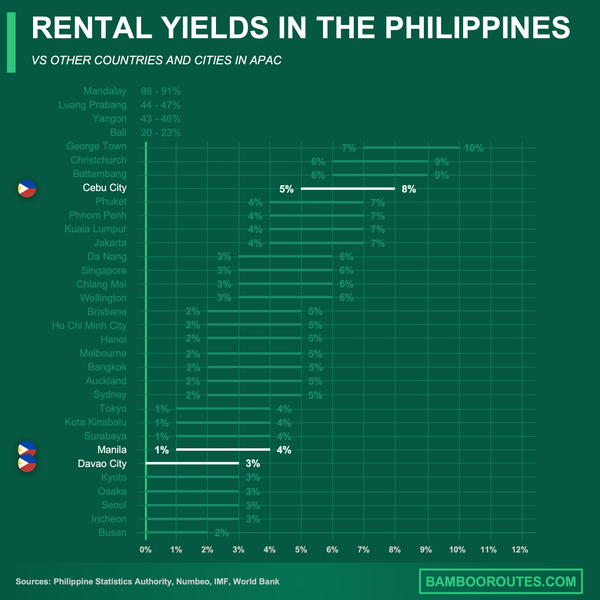Authored by the expert who managed and guided the team behind the Philippines Property Pack

Everything you need to know before buying real estate is included in our The Philippines Property Pack
Calabarzon's residential property market shows strong growth potential with steady appreciation rates and increasing demand.
The region has consistently outperformed national averages with 4-7% annual price growth, competitive selling prices, and robust rental yields that attract both end-users and investors looking for opportunities outside Metro Manila.
If you want to go deeper, you can check our pack of documents related to the real estate market in The Philippines, based on reliable facts and data, not opinions or rumors.
Calabarzon's property market forecast shows 4-6% annual price appreciation over the next 3-5 years, driven by infrastructure development and population growth.
The region offers competitive investment opportunities with rental yields averaging 4-6% and lower entry prices compared to Metro Manila.
| Market Indicator | Current Status (2025) | 5-Year Forecast |
|---|---|---|
| Annual Price Growth | 4-7% (above national average) | 4-6% projected annually |
| Average House Price | ₱10.5 million median | ₱13-15 million by 2030 |
| Price per SqM (Houses) | ₱130,000 average | ₱160-180,000 by 2030 |
| Rental Yields | 4-6% gross | Stable 4-6% range |
| New Housing Units Demand | 1.4 million shortfall | 100,000-150,000 annually |
| Population Growth | 17 million (2023) | 500,000+ increase by 2030 |
| Buyer Profile | 65% end-users, 35% investors | Trend toward more end-users |

What has been the average annual price growth of residential properties in Calabarzon over the past five years?
Residential property prices in Calabarzon have grown at an average rate of 4% to 7% annually over the past five years.
This growth rate consistently exceeds the national average for areas outside the National Capital Region (NCR), which typically shows 3% annual growth. The Philippines nationwide average ranges from 5% to 9% during recent years, but Calabarzon falls on the higher end of this spectrum.
As of 2024, Calabarzon significantly outperformed NCR with property prices rising 4.2% in the region while NCR experienced a 1% decline during the same period. This demonstrates the region's resilience and growing appeal as an alternative to Metro Manila investments.
The consistent price appreciation in Calabarzon reflects strong fundamentals including population growth, infrastructure development, and sustained demand from both local and overseas Filipino buyers.
It's something we develop in our Philippines property pack.
What are the current average selling prices per square meter in key Calabarzon cities?
| Property Type | Price Range per SqM | Typical Locations |
|---|---|---|
| Houses (Regional Average) | ₱130,000 | All Calabarzon provinces |
| Condominiums | ₱94,000 - ₱253,000 | Varies by location and project |
| Lots (Low-cost) | ₱20,000 - ₱25,000 | Cavite, Laguna, Batangas |
| Premium Lots | Up to ₱180,000 | Tagaytay and prime locations |
| Median House Price | ₱10.5 million total | Calabarzon-wide average |
How many new residential projects are launched annually in Calabarzon?
Calabarzon typically sees over 30,000 residential units launched per year through pre-selling activities.
This launch schedule has been trending upwards since 2020, driven by sustained demand and developer confidence in the market. Major developers maintain aggressive launch schedules to meet the growing demand, especially in key cities like Santa Rosa, Lipa, Antipolo, and Dasmariñas.
The region faces a significant housing shortage with approximately 1.4 million additional housing units needed as of 2024. This represents about 20% of the national unmet housing demand, creating substantial opportunities for new residential developments.
Annual housing delivery varies but developers are working to close this gap through both horizontal (houses and lots) and vertical (condominium) developments across all five provinces.
What are the current rental yields for residential properties in Calabarzon?
Residential rental yields in Calabarzon average 4% to 6% gross, depending on location and property type.
Properties near industrial zones and major transport corridors typically achieve yields on the higher end of this range. The region's lower entry prices compared to Metro Manila make these yields particularly attractive for investors seeking better returns.
Metro Manila rental yields averaged 5.28% in early 2025, with higher yields concentrated in high-demand submarkets like BGC or studio units. Calabarzon's yields are competitive while offering lower acquisition costs and potentially better long-term appreciation prospects.
The rental market benefits from the region's growing population and employment opportunities, which help maintain steady tenant demand and support rental income stability.
Don't lose money on your property in Calabarzon
100% of people who have lost money there have spent less than 1 hour researching the market. We have reviewed everything there is to know. Grab our guide now.

What are the vacancy rates for residential and commercial properties in Calabarzon?
Residential vacancy rates in Calabarzon remain low at below 10%, reflecting strong demand and population growth.
The residential vacancy trend from 2022 to 2025 shows rates are stable or declining in most areas, supported by sustained population growth and economic expansion in the region. This low vacancy rate indicates a healthy rental market for property investors.
Commercial vacancy rates are higher and more volatile in secondary markets, though still significantly lower than Metro Manila's 25%+ office vacancy rate. The commercial sector experiences more fluctuation due to shifting business demand patterns.
The sustained population growth and job creation in Calabarzon help keep residential vacancies low, making it an attractive market for rental property investment.
How much did housing loan demand grow in Calabarzon recently?
Housing loan demand in Calabarzon grew substantially in the past 12 months, with 34% of nationwide residential loans originating in the region during 2024-2025.
This significant share reflects the region's attractiveness to homebuyers and investors seeking better value compared to Metro Manila properties. The strong loan demand indicates healthy buyer confidence and market activity.
Approximately 60% to 70% of new property purchases in Calabarzon use mortgage financing. This high percentage is driven by homebuyer migration from NCR, developer financing promotions, and competitive lending rates.
The mortgage-financed purchase rate demonstrates that most buyers are leveraging financing to acquire properties, indicating both affordability programs and buyer confidence in the market's future performance.
What is the forecasted population growth for Calabarzon?
Calabarzon's population is projected to grow by over 500,000 people in the next five years from its current 17 million residents as of 2023.
This population increase is expected to create 100,000 to 150,000 new households annually, providing sustained demand for residential properties across all price segments and property types.
The population growth stems from natural increase, migration from Metro Manila due to affordability and lifestyle factors, and job creation in the region's expanding industrial and service sectors.
This demographic trend supports continued housing demand and helps explain why developers maintain aggressive launch schedules to meet the growing market needs.
What major infrastructure projects will impact Calabarzon's property market?
Major infrastructure projects scheduled for completion in the next 3-5 years include several key transportation corridors that will significantly impact property demand.
The projects include CALAX (Cavite-Laguna Expressway), SLEx Toll Road 4, Manila-Cavite Expressway (CAVITEX), Muntinlupa-Cavite Expressway, and planned regional railway expansions. These developments will dramatically reduce travel time to Metro Manila.
These infrastructure improvements are expected to impact tens of thousands of daily commuters, making Calabarzon locations more attractive for both residential and commercial development. Properties along these new corridors typically see increased demand and price appreciation.
The improved connectivity will likely boost housing demand in areas that become more accessible, creating new investment opportunities and supporting the region's overall property market growth.
It's something we develop in our Philippines property pack.

We did some research and made this infographic to help you quickly compare rental yields of the major cities in the Philippines versus those in neighboring countries. It provides a clear view of how this country positions itself as a real estate investment destination, which might interest you if you're planning to invest there.
How do OFW remittances impact Calabarzon's property market?
Overseas Filipino Workers (OFW) remittances flowing into Calabarzon are estimated at over ₱200 billion annually, providing substantial support for the property market.
Approximately 15% to 20% of these remittances are directed toward property investments and residential purchases. This represents roughly ₱30-40 billion in annual property investment from OFW funds alone.
Remittance-fueled demand remains a key driver in secondary cities and suburban developments, where OFWs often prefer to invest due to more affordable prices and better value propositions compared to Metro Manila.
This steady flow of overseas income provides consistent demand for residential properties and helps stabilize the market during economic fluctuations, making Calabarzon an attractive destination for developers and investors.
What industries are driving job creation in Calabarzon?
The top three industries driving job creation in Calabarzon are manufacturing (industrial estates), electronics/semiconductors, and automotive assembly and logistics.
These industries are expected to add 60,000 to 100,000 new jobs annually, heavily concentrated in industrial and logistics sectors. This job creation directly supports continued housing demand in growth hubs like Santa Rosa and Lipa.
The manufacturing sector benefits from Calabarzon's strategic location near Metro Manila and major ports, making it attractive for companies seeking lower costs while maintaining accessibility to markets and suppliers.
The steady employment growth in these well-paying industrial sectors creates a reliable base of potential homebuyers and renters, supporting both residential development and property investment opportunities.
How has the buyer profile shifted between end-users and investors?
The buyer profile in Calabarzon has shifted significantly toward end-users, now representing approximately 65% of buyers compared to 35% investors.
This represents a reversal from the investor-dominated trend of 5+ years ago, when investors made up a larger share of the market. The shift reflects migration from NCR driven by affordability and lifestyle factors.
Developers are increasingly tailoring products to owner-occupiers, especially in large township and master-planned communities that offer integrated lifestyle amenities and services for families.
This trend toward end-user buyers suggests market stability and genuine demand rather than speculative activity, which typically provides more sustainable long-term growth for property values.
What are the projected price appreciation rates for Calabarzon properties?
Calabarzon's residential properties are projected to appreciate at 4% to 6% annually over the next 3-5 years, supported by infrastructure growth, continued migration, and sustained economic expansion.
This forecast compares favorably to Metro Manila's projected 4% to 7% annual growth, which varies significantly by submarket with luxury and central business district properties leading gains.
Calabarzon's lower volatility combined with strong demand fundamentals makes it attractive for mid-term appreciation with lower risk than "peak price" areas in Metro Manila. The region offers more predictable returns with less speculation.
The price appreciation forecast reflects the region's balanced supply-demand dynamics, ongoing infrastructure improvements, and steady population growth that support sustainable property value increases.
It's something we develop in our Philippines property pack.
Conclusion
This article is for informational purposes only and should not be considered financial advice. Readers are advised to consult with a qualified professional before making any investment decisions. We do not assume any liability for actions taken based on the information provided.
Calabarzon's property market forecast shows promising opportunities for both investors and end-users seeking alternatives to Metro Manila's high prices.
The region's combination of steady growth, improving infrastructure, and strong fundamentals makes it an attractive option for property investment in the Philippines.
Sources
- CREBA Colliers Central Luzon Property Market Updates
- BambooRoutes Calabarzon Property Analysis
- PhilStar Property Price Growth Report
- BSP Residential Property Price Index Q1 2025
- Philippine News Agency Property Market Report
- Inquirer Business Calabarzon Homebuyer Report
- Fazwaz Philippines Calabarzon Property Listings
- BambooRoutes Calabarzon Real Estate Market Analysis
- BambooRoutes Philippines 5-Year Real Estate Forecast
- LinkedIn Philippines Rental Yields Analysis
